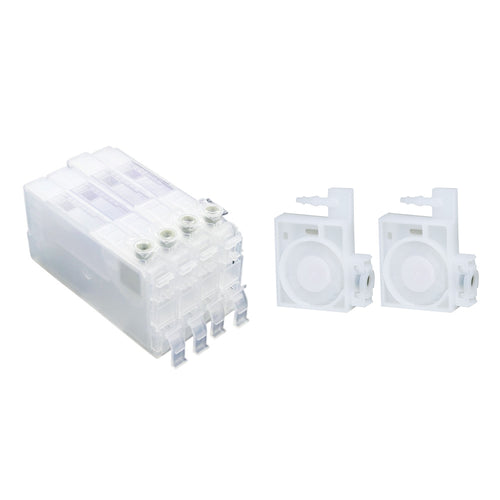What is DTG Printing?
1. Introduction:
DTG (Direct-to-Garment) printing, or "clothing direct printing", is a printing technology that directly prints images onto fabrics such as clothing. The history of this technology comes from overcoming the barrier of breaking beyond the limitation of former printing techniques, especially the increasing requirement of small orders, diversification, and high-precision tailoring.

2. Origin and History of DTG Printing
Among traditional printing methods, the most commonly used one is screen printing. This process is readily available for mass production, but small batch customization is extremely expensive and pattern details are not detailed. In order to meet the needs of the market for personalistic requirements and quick delivery, DTG print has come into existence.
DTG printing was born in the early 1990s. Its concept is as straightforward as that of inkjet printers. With ongoing technological improvement, it has evolved to meet the diversity of textiles and fabrics and become an ideal choice for personalized individualization and small-batch production.

3. How does DTG Printing Work?
The working process of DTG printing is relatively simple and can be roughly summarized into three steps:
Design and production: The print design to be printed is initially designed using the computer, and common software such as Photoshop, Illustrator, etc. are utilized for editing the images.
Pretreatment: For special fabrics or dark-colored garments, the fabric has to be pretreated first, normally by applying a layer of base ink. The layer of ink helps to improve the adhesion and depth of color of the design.
Printing process: The design is printed directly onto the clothing using a dedicated DTT printer in a very similar way that an inkjet printer prints designs onto paper. The printer sprays water-based ink on the surface of the fiber through the nozzle to obtain the details of the pattern and color vibrancy.
Heat setting: Finally, after printing, heat pressing or drying is needed to set the ink so that the pattern is firm and does not easily fall off.
4. Advantages and limitations of DTG printing
Advantages:
- High quality and detail effect: DTG printing can completely restore complex patterns, gradients, and details, especially ideal for high-precision designs such as photos, illustrations, artworks, etc.
- Low minimum order quantity and high flexibility: DTG printing does not require any plate making, and can begin to print from a single piece, highly applicable for low batches and made-to-order demands with high flexibility.
- Adjust to diversiform fabrics: DTG printing can adapt to general cotton and blends, and provide unique pattern effects on them.
- Fast delivery: Since the process is simple, DTG printing is usually faster than traditional screen printing.
Restrictions:
- Fabric requirements: DTG printing is very demanding on fabrics and best for cotton fabrics, especially pure cotton clothing. In fabrics with higher synthetic fibers (such as polyester), the adhesion and color density of the design are poor.
- Pretreatment issues: Dark-colored products require pretreatment to achieve better results, otherwise the design would not show or would be light. Pretreatment involves additional processes, which may affect production efficiency.
- High-cost issues: Although best suited for small batch printing, due to the high equipment and ink cost, the unit cost is slightly higher than in traditional methods of printing.

5. Application products of DTG printing
DTG printing is widely utilized on the following types of products:
Hoodies and T-shirts: personalized T-shirts, gift products, branded clothing items, artwork picture series.
Sportswear: personalized sportswear and school or sporting teams' jerseys.
Home decor: personalized pillowcases, bedding, window treatments, etc., to enhance the personalization of space dwelling.
Batch brand peripherals: peripheral products in small batches with independent designs or small brands.
Personalized gift products: anniversary, birthday, and holiday gifts specialized for individualized needs and team customization.
DTG printing has become the trend of customized consumption and creative design products because it is highly accurate, colorful, and personalized.
6. Comparison of DTG printing with other general printing technologies
The following table is a comparison table between DTG printing and other general printing technologies, which also includes DTF printing so that users can easily compare the two.
| DTG | Primarily cotton | Very high (suitable for photos) | 1 piece minimum | Medium | No | Suitable for personalized customization, small batch production, and detailed images |
| Silk Screen Printing | Various materials | Solid color patterns | High minimum order | Lower cost in large quantities | Yes | Efficient, cost-effective, suitable for large batch production, limited in image complexity |
| DTF Printing | Cotton/Polyester/Nylon, etc. | Rich, clear colors | Low minimum order | More flexible | No | Can print on various materials, suitable for irregular fabrics and small batch production |
DTG vs DTF printing: The most general confusion points
DTG and DTF are very confusing terms, but they are actually very different. DTG is for printing designs directly on the surface of fabrics, while DTF transfers through thermal transfer film. DTF is more suitable for irregular shapes such as polyester and nylon, and for pre-printed designs, which is suitable for a greater diversity of fabric types.
7. Summary: How to choose DTG printing by needs
DTG printing is a versatile technology that can be well utilized with fine-pattern small-batch personalization. It can suit customized designs, online commodities, and corporate commodities, particularly plain cotton materials with detailed contents and high-density colors.
But if you are printing on other materials like polyester or nylon, or if cost is an issue, then DTF printing would be a better option. Having knowledge of the pros and cons of each printing process will help you choose the most appropriate one for your product.



































